
Many park rides, shows, and attractions have a limited life span, often
opening with great fanfare, then fading in popularity or reaching the
end of their serviceable life. Especially in a corporate park setting,
as things grow older, they become expendable.
|
| |
|
|
 |
 |
 |
| |
|
|
 |
For the 1983 season,
Great Adventure added the Great Lake Grandstand as a venue for a new
Water Ski Spectacular show. This was a part of the continuation of
growth for the park under Six Flags management, with new rides and shows
being added each season as attendance was growing in the early 1980's.
While the water ski shows were popular early on, the crowds seemed to
lose interest over time, with a brief renaissance in the Time Warner era
of the 1990's when the Great Lake hosted the Lethal Weapon Stunt Show.
After that show ended the facility was used less frequently,
generally only for fireworks shows. |
 |
| |
|
 |
 |
| |
|
|
 |
 |
 |
| |
|
|
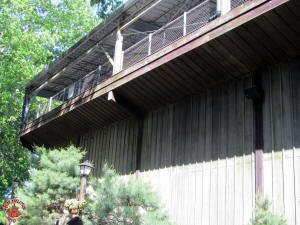 |
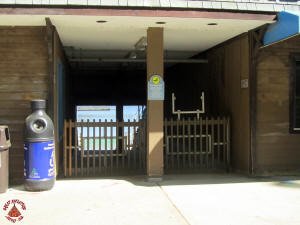 |
 |
| |
|
|
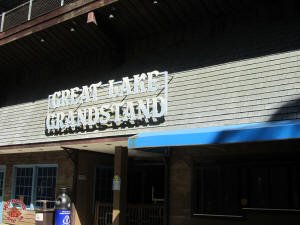 |
 |
 |
| |
|
|
 |
In preparation for 2016's The
Joker coaster which would replace the Aqua Spectacle stadium, it was
decided to demolish the aging Great Lake
Grandstand at the same time. Both facilities were in need of maintenance
that would cost more than the value of the buildings. Removing these
stadiums would create a large space for even more future development. |
 |
| |
|
|
 |
 |
 |
| |
|
|
 |
 |
 |
| |
|
|
 |
The Grandstand was a fairly
simple venue, with a steel structure supporting the rows of aluminum
bleachers and a cantilevered steel canopy. Beneath the bleachers were
former food and retail spaces which had been used for many things
over the years, as well as a large storage facility and dressing room area
from the old show productions. |
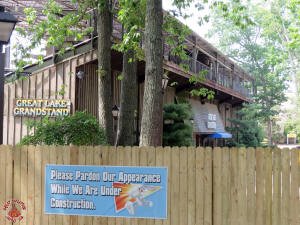 |
| |
|
|
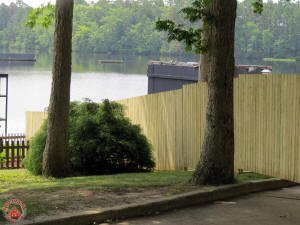 |
 |
 |
| |
|
|
 |
 |
 |
| |
|
|
 |
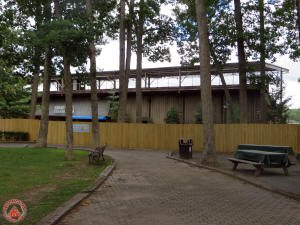 |
 |
| |
|
|
 |
Before demolition started, the
area beneath the Grandstand was cleaned out of anything valuable that
could be saved or reused. The Show Operations Department used to store
all kinds of equipment under there, and the former food stand was being
used for the strolling food vendors for many years as well. |
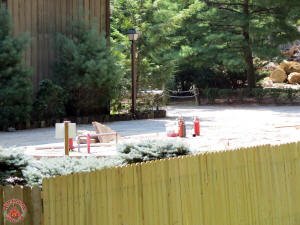 |
| |
|
|
 |
 |
 |
| |
|
|
 |
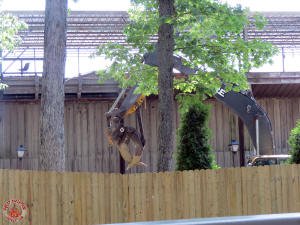 |
 |
| |
|
|
 |
 |
 |
| |
|
|
 |
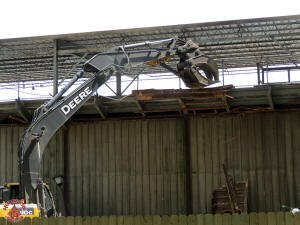 |
 |
| |
|
|
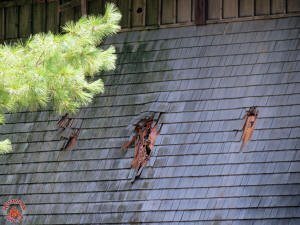 |
Once the construction fences went
up around the Grandstand in mid-July, the utilities were disconnected.
The
demolition equipment came in on August 24, 2015 and began dismantling the structure,
beginning with the wooden facades along the stadiums back pathway. Removing the facade
exposed the steel structure beneath it. |
 |
| |
|
|
 |
 |
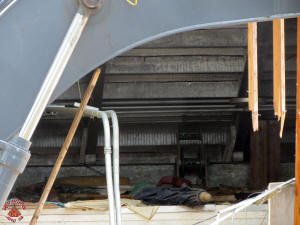 |
| |
|
|
 |
 |
 |
| |
|
|
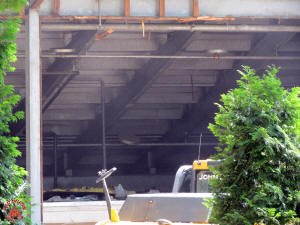 |
 |
 |
| |
|
|
 |
 |
 |
| |
|
|
 |
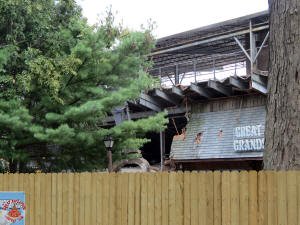 |
 |
| |
|
|
 |
Modern demolition often focuses
on sorting materials as the process happens. Removing the wooden
sections first meant the wood could get shipped off to a landfill or
recycling center separate from the more valuable and more easily
recycled steel and metal components. |
 |
| |
|
|
 |
 |
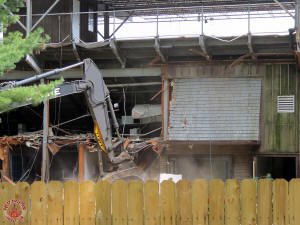 |
| |
|
|
 |
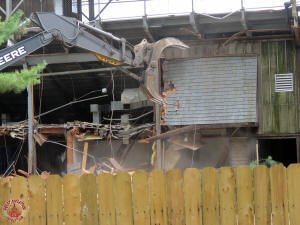 |
 |
| |
|
|
 |
 |
 |
| |
|
|
 |
Because the areas under the
Grandstand were "habitable" spaces used for making food, dressing
rooms, storage, season pass processing, etc., they had duct work for air
conditioning as well as wiring for power and other functions. |
 |
| |
|
|
 |
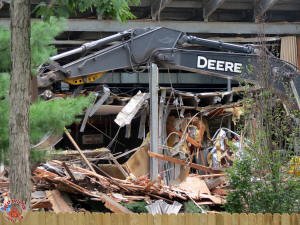 |
 |
| |
|
|
 |
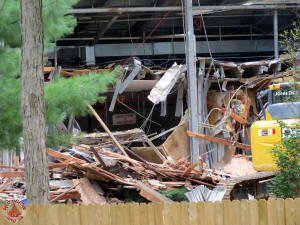 |
 |
| |
|
|
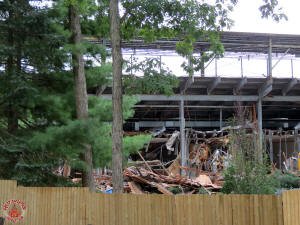 |
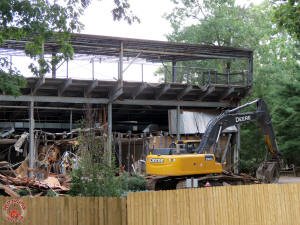 |
 |
| |
|
|
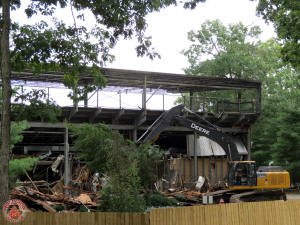 |
The stadium's former store had been used
for a time as the Six Flags TV broadcast center, so wiring was run to a
network of TV screens throughout the park. Many of those materials
pulled out of the structure had value as scrap for recycling. |
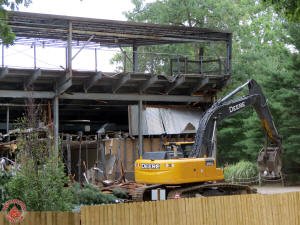 |
| |
|
|
 |
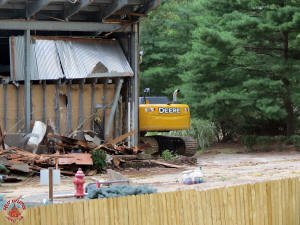 |
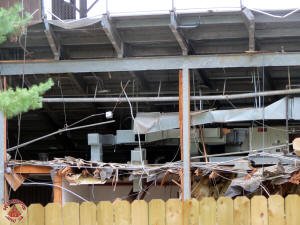 |
| |
|
|
 |
 |
 |
| |
|
|
 |
With almost all the old wooden facade
removed, the simplicity of the steel I-beam structure really showed.
Removal of the interior spaces was the most time consuming part of the
demolition, taking time to remove all of the walls that had been added
over the years. |
 |
| |
|
|
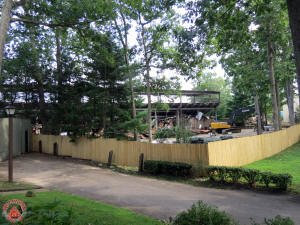 |
 |
 |
| |
|
|
 |
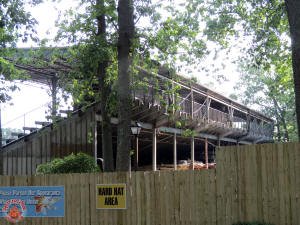 |
 |
| |
|
|
 |
 |
 |
| |
|
|
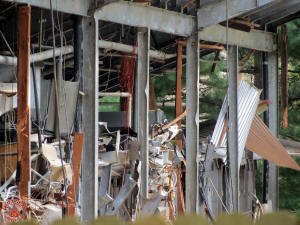 |
 |
 |
| |
|
|
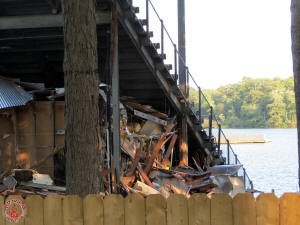 |
 |
 |
| |
|
|
 |
 |
 |
| |
|
 |
 |
| |
|
|
 |
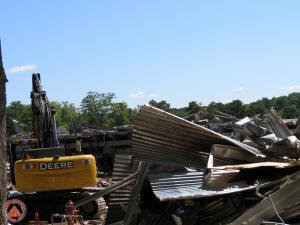 |
 |
| |
|
|
 |
 |
 |
| |
|
|
 |
 |
 |
| |
|
|
 |
Not much was recognizable in the
piles of material pulled out of the Grandstand aside from the sign that
used to hang over the center tunnel entrance to the facility. While it
looked like the sign might actually be spared, it could be later spotted
amongst the crushed rubble. |
 |
| |
|
|
 |
 |
 |
| |
|
|
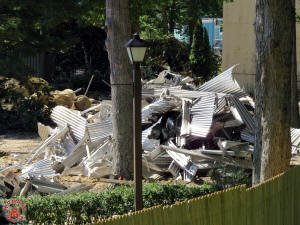 |
 |
 |
| |
|
|
 |
 |
 |
| |
|
|
 |
After just four days of
demolition, on August 28, the stadium's huge canopy had been removed and
the structure was reduced down to just one story high. Before the
equipment could make its way into the remaining portion of the building
some of the debris had to be hauled away so the equipment could reach
what still stood. |
 |
| |
|
|
 |
 |
 |
| |
|
|
 |
 |
 |
| |
|
|
 |
 |
 |
| |
|
|
 |
At this point with much of the
stadium stripped down, the inner-most hallways and passages caught their
first rays of sunlight. Deep inside, a memory wall of sorts could
be seen where performers from years past had made their mark by signing
their names and making brief notes on the sheetrock. |
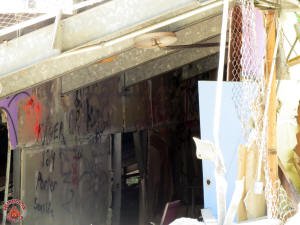 |
| |
|
|
 |
 |
 |
| |
|
|
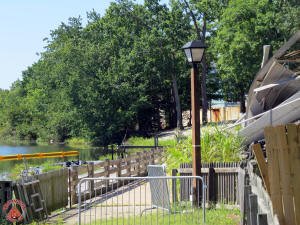 |
 |
 |
| |
|
|
 |
 |
 |
| |
|
|
 |
 |
 |
| |
|
|
 |
 |
 |
| |
|
|
 |
 |
 |
| |
|
|
 |
From aboard the Skyway, aerial
views afforded guests the opportunity to examine the demolition progress
from above. While the Great Lake still appeared tranquil, the
Great Lake Grandstand looked like it was bombed as only tangled rubble
remained. |
 |
| |
|
|
 |
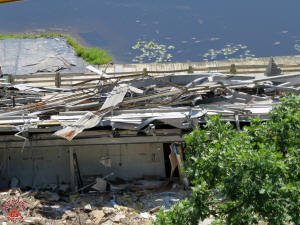 |
 |
| |
|
|
 |
 |
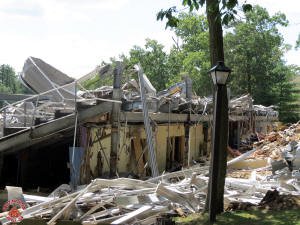 |
| |
|
|
 |
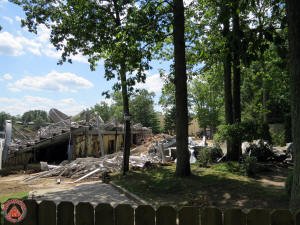 |
 |
| |
|
|
 |
 |
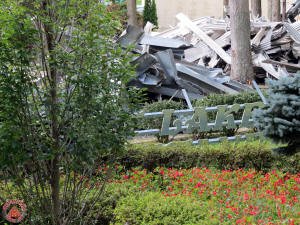 |
| |
|
|
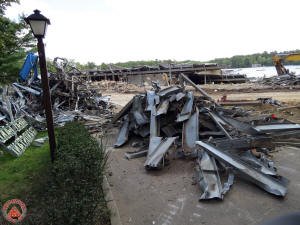 |
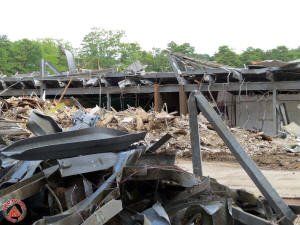 |
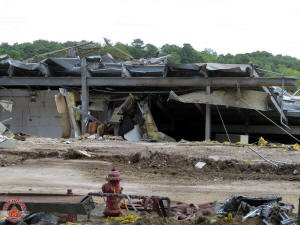 |
| |
|
|
 |
 |
 |
| |
|
|
 |
 |
 |
| |
|
|
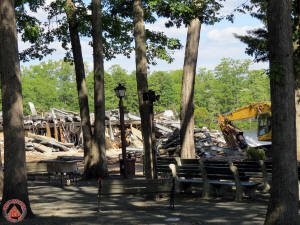 |
 |
 |
| |
|
|
 |
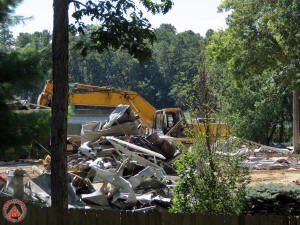 |
 |
| |
|
|
 |
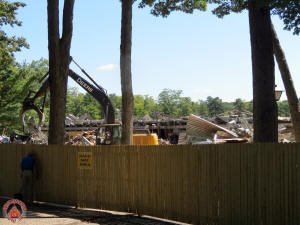 |
 |
| |
|
|
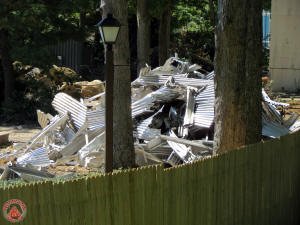 |
 |
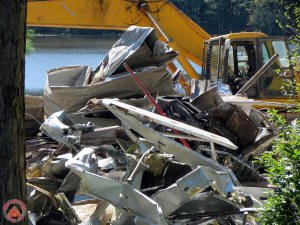 |
| |
|
|
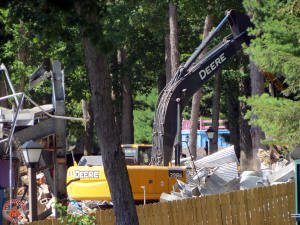 |
 |
 |
| |
|
|
 |
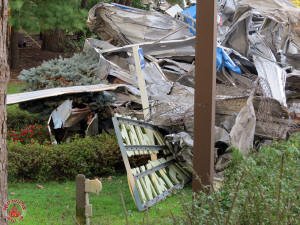 |
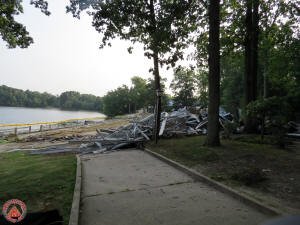 |
| |
|
|
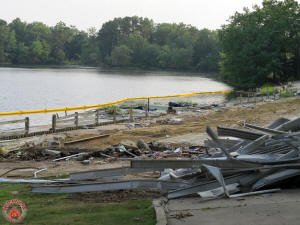 |
 |
 |
| |
|
|
 |
The piles of debris from
demolition were carted off site bit by bit with each type of material
being packed up and brought to the proper recycling facilities. With
each pile removed, the vacant plot of land seemed to grow bigger and
bigger. |
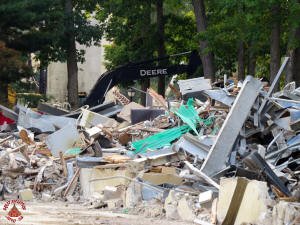 |
| |
|
|
 |
 |
 |
| |
|
|
 |
 |
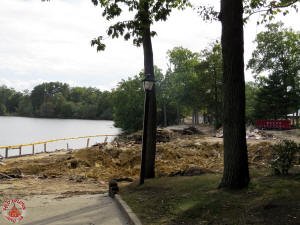 |
| |
|
|
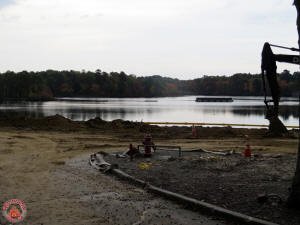 |
Finally after all the materials
were removed from the site, the land was graded along the lakefront
trying to bring it back to more or less its original profile. Without
the trees that had originally lined the Woodland Gardens area of the
park, the area looked very different. |
 |
| |
|
|
 |
 |
 |
| |
|
|
 |
 |
 |
| |
|
|
 |
 |
 |
| |
|
|
 |
In the years since the Great Lake
Grandstand was removed, the area has been fenced off and grass planted. The
site has been used as a viewing area for fireworks shows around the 4th
of July as well as other special events. For the first time since the
Great Lake Grandstand was built in 1983, over three decades later the
stadium's namesake Great Lake was once again clearly visible from the
park's shore. |
 |
| |
|
|
 |
 |
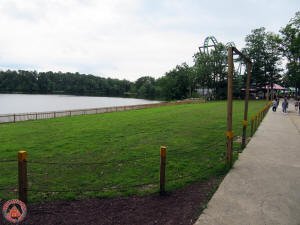 |
| |
|
|
| Original
Spotlight: August 27, 2021. GAH Reference#: SHOW-1983-001 |
| |
|
|
 |
| |
 |
 |
 |
| |
|
|



